|
To date, there have been six measurements of extreme performance with deturbulated wings on Schempp-Hirth Standard Cirrus glider
serial number 60. Data were taken by three different pilots on two dates nearly one year apart. These data show that
the sensitive conditions needed for extreme reduction of airfoil drag have to date been achieved repeatedly, though not dependably.
The first four instances occurred in
Dick Johnson's flight test evaluation (PDF) in December 2006.
Two more were measured by Jim Hendrix a year later with a new deturbulator installation.
Jim's polar essentially replicated the Dick's.
For a more survey of deturbulator performance, see
Deturbulators: Fact or Fiction
(PDF, Gliding International, 3/2009). The explanation for extreme performance may be found in the paper
Obtaining Extremely High Lift to Drag Ratios with Flexible-Wall Turbulence Control
(PDF, AIAA, 1/2009) and appears to be confirmed by
oil-flow visualizations.
Following are sink rate and glide ratio graphs for the third flight of the Johnson flight test evaluation (12/2006).
Brown curves are from Johnson's manually acquired data and red ones are from an on-board flight data recorder.
At 50 knots indicated air speed (KIAS), 48 knots calibrated, the sink rate was reduced by more than 80 feet
per minute to increase the glide ratio from 33.5 to over 60.
| Johnson Flight (12/13/2006) |
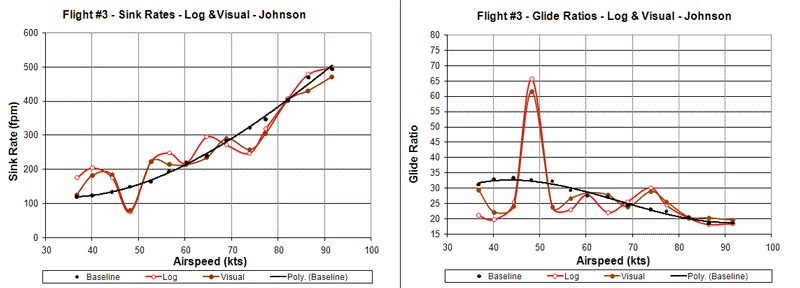 > > |
Three points in the following flight test by Johnson's assistant, Jeff Baird, are good enough to be called
extreme. Again, brown curves show manual data and red ones show log data. The points in question are
40, 45 and 70 KIAS.
| Baird Flight (12/13/2006) |
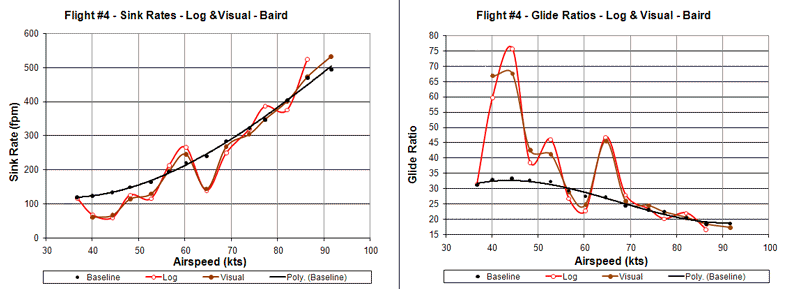 > > |
One year later, using the on-board flight logger, Jim Hendrix tested a new deturbulator installation on the
same glider and measured the performance shown below in red. The blue curves are Johnson's flight in 2006
(above). They show that Jim's flight essentially replicates Dick's; thus, demonstrating that the phenomena is repeatable.
Jim also measured points 2.5 KIAS on each side of 50 KIAS. They confirm that the width of the performance peak matches
the 4th order curve fit. They also indicate that Jim was flying about one knot too slowly for peak performance.
Finally, Jim added "error bars" to show the range of values in the three points. Since the neighboring points bracket 50:1,
the low error bar at 50 KIAS can be ignored. Also, since the speed was too slow, the performance might have reached
Johnson's measurement. In fact, the next graphs show that that happened in the second 50 KIAS speed run of the flight.
| Hendrix Flight (12/1/2007) |
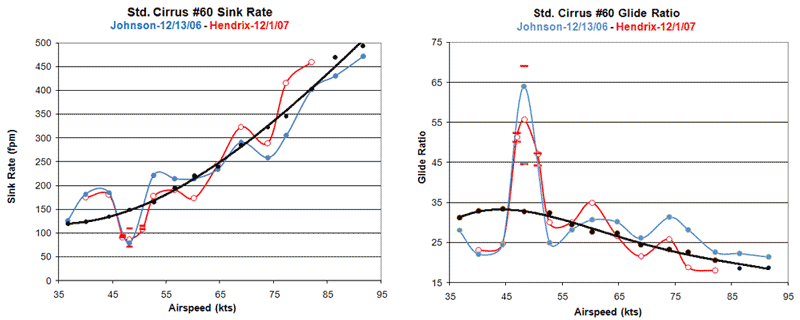 |
Knowing in-flight that he had good data, Jim took 50 KIAS data again. The graph below shows a
time-moving average of the sink rate and glide ratios at 50 KIAS from the Johnson and Hendrix flights.
Jim's second 50 KIAS measurement (brown curve) showed the glider undergoing pitch oscillations that
touch baseline performance three times and match Dick's performance twice. The characteristic shape of Dick's 50 KIAS
performance (blue) and Jim's first measurement (red) is due to poor ventilation design. The sequence progressed faster for
Jim because his deturbulator substrate had deeper channels, allowing faster ventilation action under the membrane.
Evidently, the pitch oscillations in Jim's second 50 KIAS measurement, crossed over aerodynamic conditions needed to
match Dick's steady-state measurements. Note that Jim's data points each span 28 seconds, almost half a minute,
suggesting that airframe momentum is not the reason his measurement matched Dick's.
| Time-Moving Average of Three 50 KIAS Measurements |
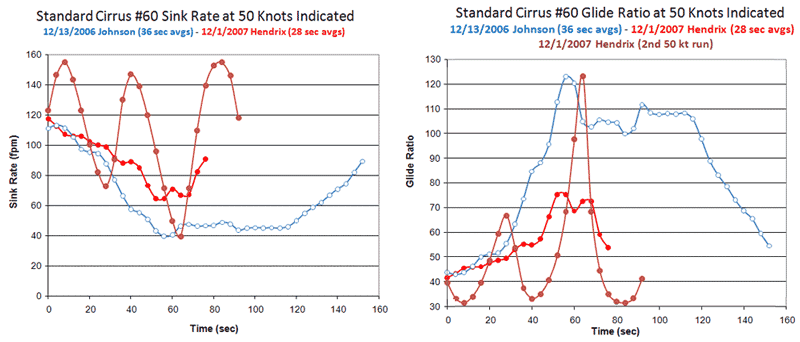 |
Raw data from the on-board flight data recorder may be extraced fromt the log files below. Click the filenames to download
the data. These are ASCII encoded (text) files formatted according to the
International Glider Commission standard.
| International Glider Commission Log Files for Flights on This Page |
| File |
Date |
Site |
KIAS |
Pilot |
Comments |
| 6CDC3R22.IGC |
12/13/2006 |
Caddo Mills, Texas |
50 |
Dick Johnson |
See second flight in log.
Third flight of 2006 Johnson test series. |
| 6CDC3R23.IGC |
12/13/2006 |
Caddo Mills, Texas |
40, 45, 70 |
Jeff Baird |
Fourth flight of 2006 Johnson test series. |
| 7C1C3R24.IGC |
12/1/2007 |
Cherry Valley, AR |
50 |
Jim Hendrix |
Second 50 KIAS measurement oscillates. |
Following is a table of the manually acquired data Dick's flight.
The pressure altitudes in this data may be used to isolate data in Dick's log file above.

Following is a table of the manually acquired data in Jeff Baird's flight.
As above, these pressure altitudes may be used to isolate data in Jeff's log file above.
 Jim notched his altitude profile to delimit his speed runs. You may refer to graph below to extract data
from his log file.
Jim notched his altitude profile to delimit his speed runs. You may refer to graph below to extract data
from his log file.
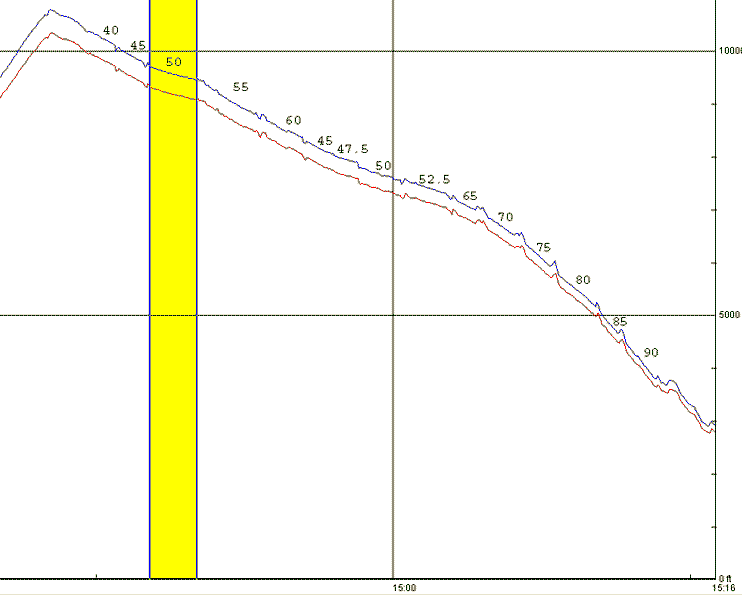
Jim Hendrix
Oxford Aero Equipment
|